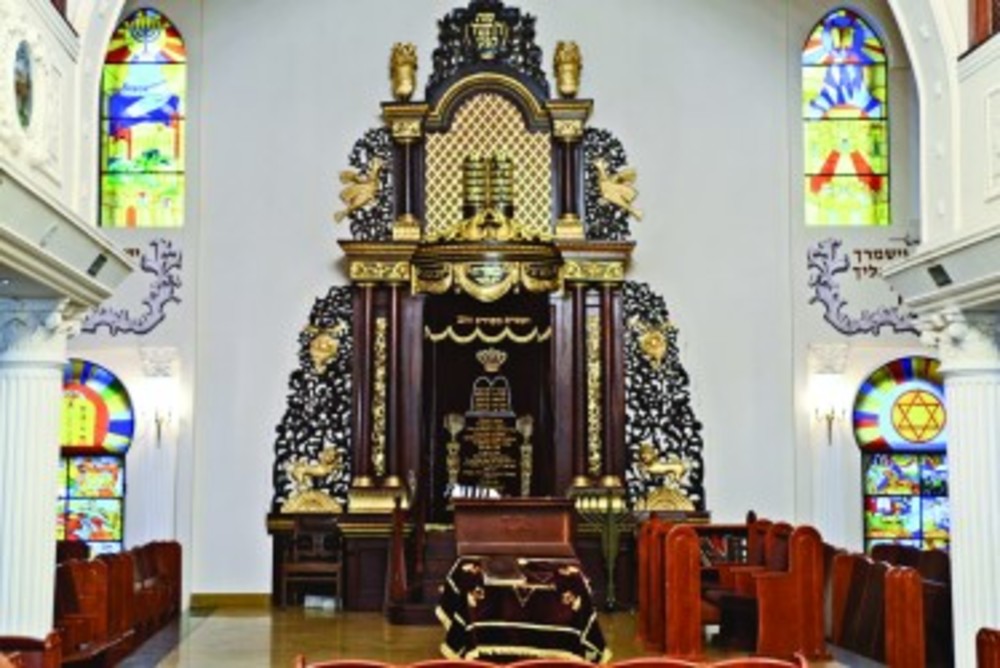Tracing history, finding roots
 Quite independently, in early October, Bernice and Dick Kumins and Mel and I made arrangements to travel to the Ukraine for a Viking River Cruise titled, “Footsteps of the Cossacks” a cruise from Odessa to Kiev on the Dnieper River.
Quite independently, in early October, Bernice and Dick Kumins and Mel and I made arrangements to travel to the Ukraine for a Viking River Cruise titled, “Footsteps of the Cossacks” a cruise from Odessa to Kiev on the Dnieper River.
The Dnieper had served as the eastern border of the Pale of Settlement in which imperial Russia had forced Jews to reside. A number of cities, towns, and shtetls along and to the west of the Dnieper were the birthplaces of many of the Hasidic dynasties of Orthodox Judaism, as well as the places from which American Jews can trace their heritage, including Mel’s mother who was born in Bila Tzerkva, a city less than 50 miles south of Kiev. Uman, Zhytomyr, Berdychiv, Machnovka and even the infamous Chernobyl – all within less than 80 miles from the Dnieper – are but a few of the many Ukrainian locations to which many American Jews can trace their ancestry.
Other than Jewish Federation or Alliance missions, Mel and I have avoided organized trips, preferring to travel to a location, rent a cottage or villa and take day trips from a central location. Not being familiar with the Russian or Ukrainian languages and unable to decipher the Cyrillic alphabet, we reasoned that a Viking River Cruise provided a safe option for selective interesting land excursions, reasonable food and comfortable accommodations, particularly since Ukraine is essentially a very new country.
It was re-established as an independent country only in 1991,with one of the lowest GNPs in Europe. As it turned out, the river cruise had an additional plus in that we were to interface daily with a crew that was 100 percent Ukrainian, all of whom were fluent in English, extremely hospitable, very friendly and anxious to assist in any way possible. In a sense, they were very representative of a country trying to regain its heritage and culture and distance itself from the former Soviet Union.
We began our journey in Odessa, which was once the jewel of Jewish learning and arts and also the birth place of many Israeli founders – Golda Meir, Meir Diezengoff, Sholem Alechem, Hayim Bialek to name a few.
Because it was the Sabbath, we were unable to see the inside of either of the two remaining Synagogues or the Community Center. We did however see the Holocaust Memorial, which was erected in 1994. Locally it is called the Via Della Rosa, as it was the way the Jews walked to the gathering point to be taken to death camps. The Memorial is on that spot of exit. The way to the stone is called the Walk of the Righteous Gentiles and is formed by trees lining both sides. The memorial was funded by private donations and is in a small park surrounded by apartment buildings.
The trip up the Dnieper River was long and followed a northerly route through five dams that flooded the valley, which then looked more like a lake like than a river. The banks were very hard to see at times, and there were very few bridges, and then only in major cities. It is understandable that the river divides the country and the lack of bridges furthers the divide. The eastern part is more Russian in language and customs, and the western side is allied with Poland in language and customs.
After a few forgettable stops, we arrived in Kiev, the capitol and largest city in the Ukraine. This is also the birth of the Hassidic movement and schools of great learning. At one time Kiev was over 30 percent Jewish, and Yiddish was a recognized language. Jews were leaders in all parts of Kiev’s society, government, arts and industry. Today the number of Jews in Kiev is about 35,000 or half of the Ukraine’s Jewish population and is slowly increasing.
There are three Kosher restaurants and three synagogues in the city. We were able to visit the Grand Choral (Podil) Synagogue. The interior was neat, cared for and looked used. The pushke was fantastic as were the newly installed gate and windows.
Kiev is also the location of Babi Yar. It was disquieting to see how close this ravine of murder was to the city center. A few shops were located across from the place the Jews started their walk down the path to the ravine. Because the city of Kiev has grown, Babi Yar is now in a nearby suburb, and there is a bus stop at Babi Yar. In September 29 – 30, 1941, over 33,000 Jews were made to march to the ravine, lined up at the rim, and shot. We visited the three monuments, one honoring the Jewish victims (paid for by the Israeli government), one honoring the children who were killed, and a third erected by the Soviets honoring all victims, including Soviet POWs, communists, Gypsies (Romani people), Ukrainian nationalists and civilian hostages, who were murdered at Babi Yar.
Were we to do this trip over, we would take a cruise on the Black Sea, where Odessa would be just a stop, and more time would be spent in Kiev.







